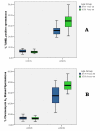Spermatozoal sensitive biomarkers to defective protaminosis and fragmented DNA
- PMID: 17760963
- PMCID: PMC2000879
- DOI: 10.1186/1477-7827-5-36
Spermatozoal sensitive biomarkers to defective protaminosis and fragmented DNA
Abstract
Human sperm DNA damage may have adverse effects on reproductive outcome. Infertile men possess substantially more spermatozoa with damaged DNA compared to fertile donors. Although the extent of this abnormality is closely related to sperm function, the underlying etiology of ensuing male infertility is still largely controversial. Both intra-testicular and post-testicular events have been postulated and different mechanisms have been proposed to explain the presence of damaged DNA in human spermatozoa. Three among them, i.e. abnormal chromatin packaging, oxidative stress and apoptosis, are the most studied and discussed in the present review. Furthermore, results from numerous investigations are presented, including our own findings on these pathological conditions, as well as the techniques applied for their evaluation. The crucial points of each methodology on the successful detection of DNA damage and their validity on the appraisal of infertile patients are also discussed. Along with the conventional parameters examined in the standard semen analysis, evaluation of damaged sperm DNA seems to complement the investigation of factors affecting male fertility and may prove an efficient diagnostic tool in the prediction of pregnancy outcome.
Figures




Similar articles
-
Sperm DNA damage: importance in the era of assisted reproduction.Curr Opin Urol. 2006 Nov;16(6):428-34. doi: 10.1097/01.mou.0000250283.75484.dd. Curr Opin Urol. 2006. PMID: 17053523 Review.
-
The impact of sperm DNA damage in assisted conception and beyond: recent advances in diagnosis and treatment.Reprod Biomed Online. 2013 Oct;27(4):325-37. doi: 10.1016/j.rbmo.2013.06.014. Epub 2013 Jul 11. Reprod Biomed Online. 2013. PMID: 23948450 Review.
-
Correlation between human clusterin in seminal plasma with sperm protamine deficiency and DNA fragmentation.Mol Reprod Dev. 2013 Sep;80(9):718-24. doi: 10.1002/mrd.22202. Epub 2013 Jul 1. Mol Reprod Dev. 2013. PMID: 23740886
-
Differences in blood and semen oxidative status in fertile and infertile men, and their relationship with sperm quality.Reprod Biomed Online. 2012 Sep;25(3):300-6. doi: 10.1016/j.rbmo.2012.05.011. Epub 2012 May 30. Reprod Biomed Online. 2012. PMID: 22818093
-
Molecular andrology as related to sperm DNA fragmentation/sperm chromatin biotechnology.Arch Androl. 2006 Jul-Aug;52(4):299-310. doi: 10.1080/01485010600668363. Arch Androl. 2006. PMID: 16728346 Review.
Cited by
-
Sperm DNA fragmentation and oxidation are independent of malondialdheyde.Reprod Biol Endocrinol. 2011 Apr 14;9:47. doi: 10.1186/1477-7827-9-47. Reprod Biol Endocrinol. 2011. PMID: 21492479 Free PMC article.
-
Protection against Cyclosporine-Induced Reprotoxicity by Satureja khuzestanica Essential Oil in Male Rats.Int J Fertil Steril. 2016 Jan-Mar;9(4):548-57. doi: 10.22074/ijfs.2015.4615. Epub 2015 Dec 23. Int J Fertil Steril. 2016. PMID: 26985344 Free PMC article.
-
Flow cytometry for the assessment of animal sperm integrity and functionality: state of the art.Asian J Androl. 2011 May;13(3):406-19. doi: 10.1038/aja.2011.15. Epub 2011 Apr 11. Asian J Androl. 2011. PMID: 21478895 Free PMC article. Review.
-
Effect of Spermatic Nuclear Quality on Live Birth Rates in Intracytoplasmic Sperm Injection.J Hum Reprod Sci. 2019 Apr-Jun;12(2):122-129. doi: 10.4103/jhrs.JHRS_81_18. J Hum Reprod Sci. 2019. PMID: 31293326 Free PMC article.
-
Sperm chromatin: fertile grounds for proteomic discovery of clinical tools.Mol Cell Proteomics. 2008 Oct;7(10):1876-86. doi: 10.1074/mcp.R800005-MCP200. Epub 2008 May 25. Mol Cell Proteomics. 2008. PMID: 18504257 Free PMC article. Review.
References
-
- Aitken RJ, De Iuliis GN. Origins and consequences of DNA damage in male germ cells. Reprod Biomed Online. 2007;14:727–733. - PubMed
Publication types
MeSH terms
Substances
LinkOut - more resources
Full Text Sources
Other Literature Sources
Medical

